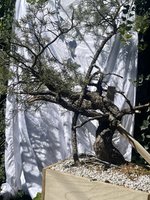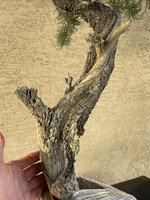Hartinez
Masterpiece
The piñon pine. Yes I’m referring to New Mexico based pine not the Colorado pinyon, which I’m convinced the only difference is the lack of the ñ in the spelling and pronunciation. But that’s more shit talk that biological knowledge.
I’ve long thought these could be phenomenal specimen for bonsai. Not only for their needle size, rugged craggy bark, twisty forms, but also the cultural and historical importance they hold for northern New Mexican peoples and the possibilities available in the presentation of the trees in shows and exhibits.
I’m not the only one who has thought this, but they are notoriously difficult to dig. I’d say a big reason for this is the conditions in which many grow. Low water, sandy soils that have little to no feeder roots and massive tap roots. But I have found many instances where these trees are quite collectible and have had great success over the last 3 years or so. I’ve collected 9 trees over the last 3 years with 7 of them surviving and thriving. Most of these trees while nice trees in there own right we’re just ok trees and lacking that certain factor that sets them apart.
With so much success lately, I have attempted over the last few weeks to dig some pretty bad ass and size-able specimen that I’m very excited about. These 3 were collected in the same way I collected all the others and there is no reason they wouldn’t respond the same. But we shall see!!!
Great bends, massive trunk, craggy bark, healthy buds. Here’s the best pics I have. (There is a second piñon in the box that came with this one at collection cause they were growing together)


The other 2.




I’ve long thought these could be phenomenal specimen for bonsai. Not only for their needle size, rugged craggy bark, twisty forms, but also the cultural and historical importance they hold for northern New Mexican peoples and the possibilities available in the presentation of the trees in shows and exhibits.
I’m not the only one who has thought this, but they are notoriously difficult to dig. I’d say a big reason for this is the conditions in which many grow. Low water, sandy soils that have little to no feeder roots and massive tap roots. But I have found many instances where these trees are quite collectible and have had great success over the last 3 years or so. I’ve collected 9 trees over the last 3 years with 7 of them surviving and thriving. Most of these trees while nice trees in there own right we’re just ok trees and lacking that certain factor that sets them apart.
With so much success lately, I have attempted over the last few weeks to dig some pretty bad ass and size-able specimen that I’m very excited about. These 3 were collected in the same way I collected all the others and there is no reason they wouldn’t respond the same. But we shall see!!!
Great bends, massive trunk, craggy bark, healthy buds. Here’s the best pics I have. (There is a second piñon in the box that came with this one at collection cause they were growing together)


The other 2.




